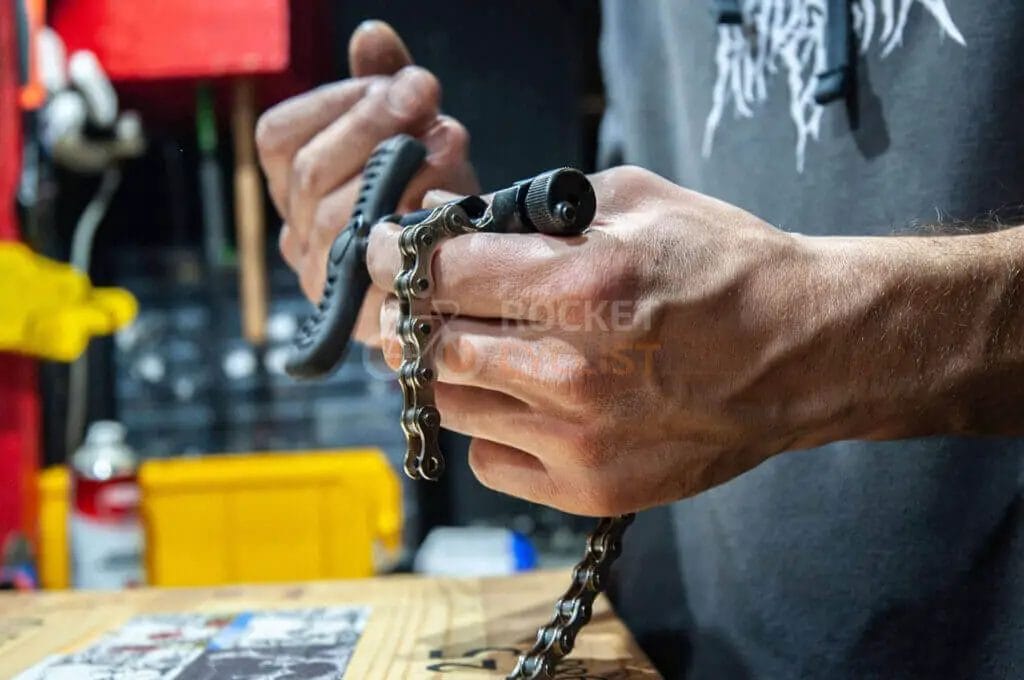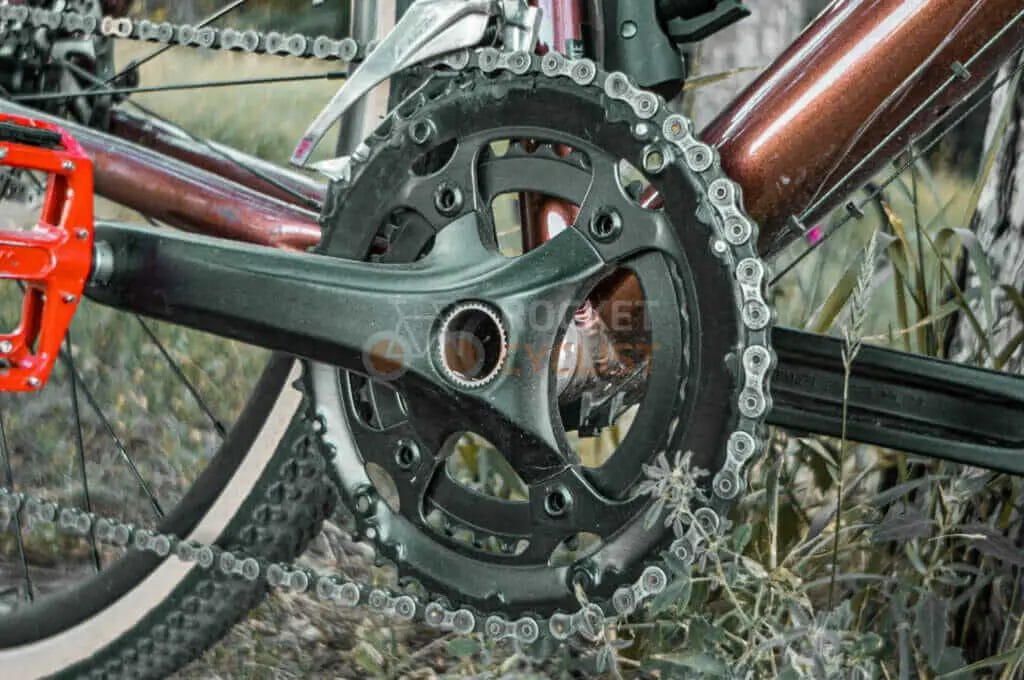Last Updated on March 17, 2024 by Vinson Lozano

Understanding Chainring Sizes and Chain Compatibility
When it comes to changing chainring sizes, it’s important to understand how they impact your chain’s compatibility. The chainring size refers to the number of teeth on the chainring, which directly affects the gear ratio and overall performance of your bike.
Different chainring sizes require different lengths of chain to ensure proper tension and functionality. Changing to a larger chainring size may require adding additional links to your chain or even replacing it altogether. On the other hand, switching to a smaller chainring size may require removing links from your chain to avoid slack.
To ensure a smooth transition and optimal performance, it’s crucial to consider the compatibility between your new chainring size and your existing chain when making any changes. It’s always recommended to consult a professional or refer to the manufacturer’s guidelines for the best results.
Chainring size and its impact on chain compatibility
When it comes to changing your chainring size, it’s essential to understand how it can affect the compatibility of your chain. The chainring size refers to the number of teeth on the chainring, and it directly influences the gear ratio and overall performance of your bike.
Different chainring sizes require different lengths of chains to ensure proper tension and functionality. If you decide to switch to a larger chainring size, you may need to add additional links to your chain or replace it entirely. Conversely, opting for a smaller chainring size might mean removing links to prevent slack.
To ensure a smooth transition and optimal performance, it’s crucial to consider the compatibility between your new chainring size and your existing chain. By consulting a professional or referring to the manufacturer’s guidelines, you can make the necessary adjustments for a seamless ride.
Factors to consider when changing chainring size

When changing the chainring size, there are several factors you need to consider to ensure optimal performance.
- Gear Ratio: Changing the chainring size will affect the gear ratio, which determines how easy or hard it is to pedal. If you want more power or speed, you may consider increasing the chainring size. Conversely, if you want easier pedaling, a smaller chainring size may be suitable.
- Compatibility: Not all chainrings are compatible with all drivetrains. Check the specifications of your bike’s drivetrain to ensure that the new chainring size you choose is compatible with the chain, cassette, and front derailleur.
- Chain Length: Changing the chainring size may require adjusting the chain length. A larger chainring may require adding links to the chain, while a smaller chainring may require removing links to avoid slack.
- Riding Style: Consider your riding style and terrain. If you frequently ride steep hills or prefer a high cadence, a smaller chainring may be more suitable. If you ride on flat terrain and want to maximize speed, a larger chainring may be better.
Taking into account these factors will help you choose the right chainring size for your riding preferences and ensure compatibility with your drivetrain.
Importance of Chain Maintenance

Proper chain maintenance is crucial for ensuring smooth and efficient operation of your bike. Regular maintenance not only extends the lifespan of your chain, but it also enhances the overall performance of your drivetrain. Neglecting chain maintenance can lead to various issues such as increased friction, poor shifting performance, and accelerated wear on other drivetrain components. By keeping your chain clean and lubricated, you reduce the risk of rust, corrosion, and dirt buildup, which can cause unnecessary wear and tear. Additionally, regular inspection allows you to identify any signs of damage or excessive wear, enabling you to address them before they cause further issues. Making chain maintenance a priority will ultimately result in a more enjoyable and efficient cycling experience.
Effects of chainring size change on chain wear
When changing the chainring size on your bike, it is important to consider the potential effects on chain wear. A larger chainring will typically result in a higher chain tension and increased stress on the chain. This can lead to accelerated wear and a shorter lifespan for the chain. On the other hand, a smaller chainring may reduce chain tension and decrease wear. It is essential to monitor your chain closely after changing the chainring size and inspect it regularly for signs of elongation or damage. If you notice excessive wear or stretching, it is advisable to replace the chain to prevent further damage to other drivetrain components. Maintaining the proper chainring size can contribute to the longevity and performance of your chain.
Signs that indicate a need for chain replacement
There are several key signs that indicate a need for chain replacement. One of the most obvious signs is excessive chain wear. You can check for this by placing a ruler against the chain and measuring the distance between the pins. If the measurement exceeds 0.5% of the chain’s original length, it’s time to replace it. Additionally, a chain that skips or slips under load is a clear sign of wear and may indicate that the chainring is not meshing properly with the chain. Another indication is if you notice a rough or noisy pedaling experience. These signs should not be ignored, as a worn chain can cause damage to the rest of the drivetrain components and compromise your bike’s performance.
Upgrading Chainring Size: Considerations

When considering upgrading your chainring size, there are a few important factors to keep in mind. First and foremost, changing the chainring size can have a significant impact on your bike’s overall performance. Increasing the chainring size will provide a higher gear ratio, making it easier to pedal at higher speeds, while decreasing the chainring size will offer a lower gear ratio, ideal for climbing steep hills or riding in stop-and-go traffic. However, it’s crucial to ensure compatibility with your bike’s drivetrain components. Check if the new chainring is compatible with the chain and derailleur, as well as the number of speeds on your bike. Consulting with a bike expert or your local bike shop can help you select the appropriate chainring size and ensure a smooth transition without compromising your bike’s functionality.
How changing chainring size affects chain performance
When you change the chainring size on your bike, it can have a significant impact on your chain’s performance. Increasing the chainring size will result in a higher gear ratio, allowing you to pedal easier at higher speeds. This can lead to increased speed and efficiency on flatter terrain. On the other hand, decreasing the chainring size will give you a lower gear ratio, which is ideal for climbing steep hills or riding in stop-and-go traffic. The change in gear ratio can affect how your chain engages with the chainring and cassette, potentially requiring adjustments to ensure smooth shifting. It is important to consider how changing the chainring size will impact your specific riding needs and bike setup.
Compatibility issues to watch out for
When changing the chainring size on your bike, it’s important to be aware of potential compatibility issues that may arise. One key consideration is the compatibility between your new chainring size and your rear cassette. If the chainring is too big or too small, it may not align properly with the teeth of the cassette, resulting in poor shifting performance or even chain slippage. Additionally, you should also check if your derailleur can handle the new chainring size. Some derailleurs have a maximum capacity for accommodating larger or smaller chainrings, so it’s essential to ensure that your derailleur can handle the change. By paying attention to these compatibility issues, you can ensure smooth and efficient gear shifting with your new chainring size.
Recommended Actions When Changing Chainring Size
When changing the chainring size on your bike, there are a few recommended actions you should take to ensure optimal chain function. Here are some steps you should consider:
- Check chain length: When changing to a larger chainring, you may need to add a few links to your chain to accommodate the new size. Conversely, if you’re switching to a smaller chainring, you may need to remove a few links. Use a chain breaker tool to adjust the length accordingly.
- Test chain tension: After adjusting the chain length, make sure to check the tension. You want the chain to have a slight amount of slack – not too loose or too tight. This can impact shifting performance and overall drivetrain efficiency.
- Inspect and replace worn components: When changing the chainring size, it’s a good idea to inspect other drivetrain components, such as the cassette, derailleur, and chain. If any of these components are worn or damaged, it’s best to replace them to ensure smooth and accurate shifting.
- Fine-tune shifting adjustments: Changing the chainring size may require minor adjustments to the front and rear derailleur. Use the barrel adjusters to fine-tune the shifting and ensure precise gear changes.
By following these recommended actions, you can ensure that your chain functions optimally and that your bike performs at its best with the new chainring size. Remember to always consult the manufacturer’s guidelines and seek professional assistance if needed.
Steps to take to ensure optimal chain function
When changing the chainring size on your bike, you want to ensure optimal chain function. Here are some steps you should take:
- Check chain length: After changing the chainring size, you may need to adjust the length of your chain. Use a chain breaker tool to add or remove links as necessary. This will ensure that the chain is properly tensioned and can smoothly engage with the new chainring.
- Test chain tension: Once you have adjusted the chain length, check the tension. You want the chain to have a slight amount of slack – not too loose or too tight. Improper tension can cause poor shifting and increased wear on your drivetrain.
- Inspect and replace worn components: Changing the chainring size is a good opportunity to inspect other drivetrain components. Check the cassette, derailleur, and chain for wear and damage. If any components are worn, it’s best to replace them to ensure smooth and accurate shifting.
- Fine-tune shifting adjustments: With the new chainring size, you may need to make minor adjustments to the front and rear derailleur. Use the barrel adjusters to fine-tune the shifting and ensure precise gear changes.
By following these steps, you can ensure that your chain functions optimally and your bike performs at its best with the new chainring size. Always consult the manufacturer’s guidelines and seek professional assistance if needed.
Tips for adjusting chain length and tension
When adjusting chain length and tension after changing the chainring size, here are some tips to follow:
- Measure twice, cut once: Before removing or adding links, double-check the chain length to ensure you have the correct number of links for optimal tension. Cutting too many links can make the chain too short, while leaving it too long will result in excess slack.
- Use a chain breaker tool: When removing or adding links, use a chain breaker tool to break the chain at the desired point. Be careful not to damage the chain by applying too much force.
- Test the tension: After adjusting the chain length, test the tension by pushing down on the chain midway between the front and rear chainrings. You should have a slight amount of slack, about half an inch or 12-15mm.
- Fine-tune with derailleur adjustments: If the tension is too loose or too tight, use the barrel adjusters on the front and rear derailleurs to make precise adjustments. Turn the adjusting barrel in small increments until the tension is just right.
Remember, proper chain tension is crucial for smooth shifting and efficient power transfer. Take your time and make small adjustments until you achieve the optimal tension for your new chainring size.
Professional Insights on Chain Changes
When it comes to chain changes and adjusting chainring sizes, it’s always helpful to seek insights from professionals in the field. Experts emphasize the importance of maintaining the optimal chain length and tension for optimal performance. They recommend measuring twice and cutting once to ensure the correct number of links. Additionally, using a chain breaker tool is crucial for removing or adding links without causing any damage. Professionals also stress the need for testing the tension and making fine-tune adjustments using the derailleur’s barrel adjusters. By taking these measures, you can ensure a smooth and efficient chain function. Don’t hesitate to consult with experts for guidance and assistance in achieving the best results with your chain changes.
Expert opinions on changing chainring size
Experts generally agree that changing the chainring size can have a significant impact on the overall performance of your chain and drivetrain. Sizing up or down can affect the way the chain engages with the chainring teeth and the shifting behavior of the derailleur.
Many experts recommend assessing your riding style and terrain before making any changes. For example, if you frequently tackle steep climbs, a smaller chainring can provide easier gearing. On the other hand, if you frequently ride on flat roads or need higher speeds, a larger chainring can help optimize your cadence.
It’s crucial to consult with professionals who can provide personalized advice based on your specific needs and bike setup. They can help ensure that the new chainring size is compatible with your drivetrain components and provide guidance on any necessary adjustments for optimal performance.
Common mistakes and how to avoid them
When changing the chainring size, there are a few common mistakes that many people make. One mistake is not properly assessing their riding style and terrain before making the change. It’s important to consider factors such as steep climbs or flat roads to determine the appropriate chainring size for your needs.
Another common mistake is not consulting with professionals or experts before making the change. They can provide valuable advice on compatibility issues and necessary adjustments for optimal performance.
Additionally, some people forget to properly adjust the chain length and tension after changing the chainring size. This can lead to poor shifting, chain skipping, or even chain damage.
To avoid these mistakes, be sure to assess your riding needs, consult with experts, and make the necessary adjustments to ensure proper chain function.
Conclusion
In conclusion, when changing the chainring size on your bike, it is important to assess your riding style and terrain to determine the appropriate chainring size for your needs. This ensures optimal performance and efficiency. Additionally, maintaining your chain is crucial for smooth shifting and overall bike performance. If you decide to change the chainring size, be aware of the potential impact it can have on chain wear and consider replacing the chain if needed. It is recommended to consult with professionals or experts to ensure compatibility and make the necessary adjustments for optimal chain function. By following these steps and avoiding common mistakes, you can successfully change your chainring size and enjoy a better riding experience.
Key takeaways on changing chainring size and chain replacement
When considering changing the chainring size on your bike, keep these key takeaways in mind. First, assess your riding style and terrain to determine the appropriate chainring size for your needs. This will ensure optimal performance and efficiency. Secondly, be aware that changing the chainring size can accelerate chain wear, so inspect your chain regularly and replace it if needed. Remember that a worn chain can lead to poor shifting and decreased performance. Lastly, seek professional advice and guidance to ensure compatibility and make the necessary adjustments for optimal chain function. By following these key takeaways and avoiding common mistakes, you can successfully change your chainring size and enjoy an improved riding experience.
Resources for further information and assistance
For additional information and assistance on changing chainring sizes and replacing your chain, there are several resources available to you. Some useful sources include:
- Bicycle manufacturer’s website: Visit the website of your bike’s manufacturer for specific information and recommendations on chainring sizes and compatibility.
- Bike forums and online communities: Engage in discussions with fellow cyclists who have experience in changing chainring sizes. They can provide firsthand insights and tips to help you navigate the process.
- Local bike shop: Consult with professional bike mechanics at your local bike shop. They can provide expert advice on chainring sizing, compatibility, and proper installation.
Remember, gathering information and seeking professional guidance is crucial to ensure a successful chainring size change without compromising your bike’s performance.


